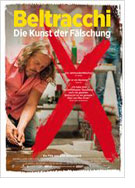

Opening 6 Mar 2014
Directed by:
Arne Birkenstock
Writing credits:
Arne Birkenstock
With great concentration and a forceful movement of his brush Wolfgang Beltracchi leans over a large canvas on the floor of his studio. With his free hand he is keeping strands of his hippie-style long hair out of his face. We are looking at an artwork with vibrant colours proudly shown-off by the painter. He is a cheerful man casually talking of his working methods. His wife Helene lends him a helping hand. They seem to be a well functioning team. And indeed they are. Over the years they had sold many paintings and have amassed millions of euros. They bought several cars, built super-luxury mansions in Freiburg and Mèze, owed a sailing yacht and had lived on a wine estate in southern France with their two children.
Beltracchi (born as Wolfgang Fischer in 1951) painted his first “Picasso” at the age of 14, and in the 1970s he had his first exhibitions in Aachen and Munich. It followed a stay in Maroc during the hippie years of the ‘80s when he developed the idea of faking world-renowned modern painters. With the help of a friend the works were sold all over Europe and even beyond. He meets Helene and they fall in love. This was in 1992. When he tells her of his “occupation” she is fascinated. They marry and he adopts her name. The two develop a daring scheme by making up a story of her grandfather’s art depot, and the Collection Werner Jäger is born. The paintings were supposedly acquired from the famous gallery Alfred Flechtheim as well as other distinguished galleries. For this purpose Beltracchi creates his own faked gallery labels. As we see in the course of the film, he also fabricates his own framing, prepares his own antique colours, collects dust from old pictures to embellish his new ones and – best of all – has a good story to tell about the origin of the long-lost master works. He goes about his task so thoroughly, so professionally and with such positive self-assurance that the viewer, even against his will, can only be fascinated by his chutzpah.
Helene too pays a very important role in this game. The slender, good looking woman with her flowing hair has to get in touch with galleries, offer the paintings and be convincing about the authenticity. Admittedly, she felt a bit nervous at the beginning but relaxed after experiencing how easy the sales are, despite the experts and their probing. Her husband maintains that it is much easier to sell a million euro piece than a 5.000 euro one. “When you ask for so much money, nobody suspects a fraud”. And provisions are made along the way by auctioneers, middlemen and galleries. We learn a lot about the overheated situation on the art market where quick money can be made. This situation also makes it more prone to fraudulent schemes.
During a hectic art auction works for 13 million British pounds are going under the hammer within minutes. Sofie Kormarova of a Geneva gallery confirms that the buyers have mainly financial interests. The art critic Niklas Maak explains why everyone involved is only too pleased hearing of a re-discovered work of an old master, keen for fresh investing possibilities. “But all good things come to an end”, as Beltrucchi sadly admits. He would have liked to sell one or two more works before quitting so that he could fulfil his dream of owing a Venice palace. He regrets that instead he now has to live in a small cell.
Beltrucchi’s fake painting of Heinrich Campendonk “Red painting with Horses” was auctioned for a record price of 2.8 million euros in 2006 after which it came to the first complications. During an analysis made in 2008 a wrong pigment in the white paint had been found. After that more fakes were discovered and the couple was arrested. The 14 paintings disputed during the court case had caused about 16 million euros damage. Most of it could be covered by the sale of their properties. According to Beltrucchi he had sold about 300 pieces all over the world. Only few have since been found.
I wondered how we could be watching Beltrucchi demonstrating his tricks, listening to his expertise and his stories of how to enjoy life, when he had been sentenced to a six-year prison term at the end of 2011? The explanation is that he and his wife were able to move freely for about three months before taking up their sentence. After some time in prison they were permitted to leave for work during the day (it’s called: “freier Vollzug”) but had to return at night. Apart from working together in their Cologne studio, they have in the meantime also published a book.
Arne Birkenstock’s documentary, with cameraman Marcus Winterbauer, is a very entertaining art thriller. At the same time it is informative, colourful and sometimes funny with fast-moving collages of Beltracchi’s adventurous life. This certainly is one of the biggest art scandals shaking a whole industry and leaving many open questions. (Birgit Schrumpf)